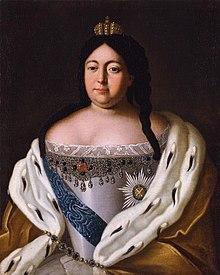| Anna | |||||
|---|---|---|---|---|---|
 | |||||
| Empress of Russia | |||||
| Reign | 26 (15) February 1730 – 28 (17) October 1740 | ||||
| Coronation | 28 April (9 May) 1730 | ||||
| Predecessor | Peter II | ||||
| Successor | Ivan VI | ||||
| Born | 7 February 1693 Moscow, Tsardom of Russia | ||||
| Died | 28 October 1740 (aged 47) Saint Petersburg, Saint Petersburg Governorate, Russian Empire | ||||
| Burial | |||||
| Spouse | |||||
| |||||
| House | Romanov | ||||
| Father | Ivan V of Russia | ||||
| Mother | Praskovia Saltykova | ||||
| Religion | Russian Orthodox | ||||
| Signature |  | ||||
Anna Ioannovna (Russian: Анна Иоанновна; 7 February [O.S. 28 January] 1693 – 28 October [O.S. 17 October] 1740), also russified as Anna Ivanovna[1] and sometimes anglicized as Anne, served as regent of the duchy of Courland from 1711 until 1730 and then ruled as Empress of Russia from 1730 to 1740. Much of her administration was defined or heavily influenced by actions set in motion by her uncle, Peter the Great (r. 1682–1725), such as the lavish building projects in St. Petersburg, funding the Russian Academy of Science, and measures which generally favored the nobility, such as the repeal of a primogeniture law in 1730. In the West, Anna's reign was traditionally viewed as a continuation of the transition from the old Muscovy ways to the European court envisioned by Peter the Great.[1] Within Russia, Anna's reign is often referred to as a "dark era".[2]
- ^ a b Baynes 1878.
- ^ Lipski 1956, p. 488.